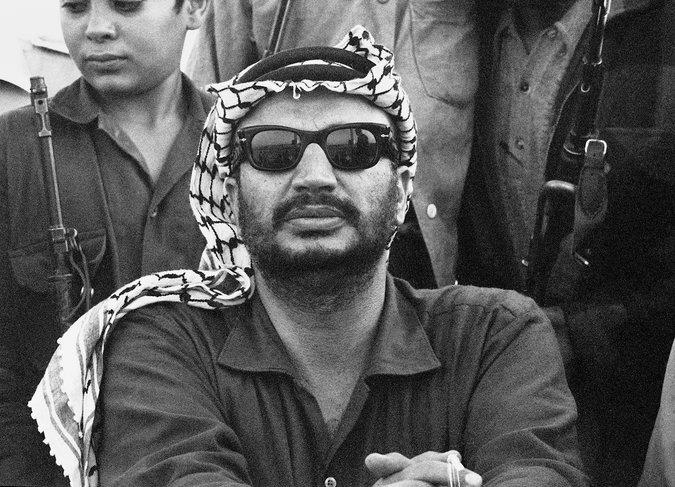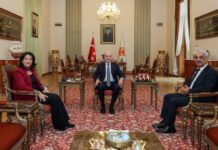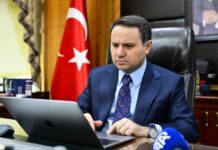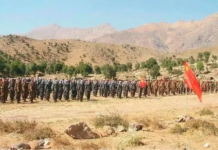By Ronen Bergman, January 23, 2018
The radar on the F-15s picked up the blip of the transport plane, a DHC-5 Buffalo, 370 miles into Mediterranean airspace. The fighters closed rapidly. They read the tail number, saw the blue-and-brown markings. They were positive they’d found the right plane.
The lead pilot keyed his radio. “Do we have permission to engage?”
It was the afternoon of Oct. 23, 1982. Deep beneath the ground of central Tel Aviv, inside the Israeli Air Force’s main command-and-control bunker, code-named Canary, the pilot’s question played over a loudspeaker. All eyes were on the commanding officer. Everyone expected an order to open fire, but the air-force commander in chief, Maj. Gen. David Ivry, usually a decisive man, was hesitating.
He knew that his fighters had everything they were supposed to have: a positive visual identification, a clear shot in open skies over empty ocean. The go-ahead to shoot down the plane and the passenger it was carrying had come from the minister of defense, Ariel Sharon. Their job — Ivry’s job — was to eliminate targets, not select them.
But Ivry’s doubts overcame him. “Negative,” he told the pilot. “I repeat: Negative on opening fire.”
The military operation — the targeted assassination of Yasir Arafat, chairman of the Palestine Liberation Organization and enemy of the state of Israel — had been set in motion the previous day by Mossad, Israel’s civilian intelligence agency. Tsomet, the Mossad unit responsible for recruiting and running assets abroad, received reports from two informants inside the P.L.O. that Arafat would take off from Athens the next day in a private plane heading to Cairo. Caesarea, the Mossad unit that handled targeted killings, immediately dispatched two operatives to gather more information. Taking advantage of lax security at the Athens airport, they waited for Arafat in the area where private planes were parked.
Sharon, meanwhile, had been maintaining constant pressure on Lt. Gen. Rafael Eitan, chief of staff of the Israeli Defense Forces, for the operation to move forward. The air force put two F-15 fighters on alert for immediate takeoff from the Tel Nof air force base. Ivry, ever cautious, briefed the lead pilot himself. He understood the stakes. It was clear to him how disastrous it would be if Israel shot down the wrong aircraft. “You don’t fire without my O.K.,” he told the pilot. “Clear? Even if there’s a communications problem, if you don’t hear my order” — he emphasized that part: hear my order — “you don’t open fire.”
At 2:05 p.m. on Oct. 23, one of the Caesarea operatives in Athens called Mossad headquarters. “He’s here,” he said. “Positive ID.” His excitement was audible. He reported that he had watched the P.L.O. leader and his men making final preparations to board a DHC-5 Buffalo with a tail painted blue with brown marks and the registration number 1169.
Detail from above. The photograph was one of several taken by a team of Israeli snipers in position in Beirut as Arafat prepared to evacuate the city. The snipers were ordered to stand down by the Israeli prime minister, Menachem Begin, who had promised the U.S. that no harm would be inflicted on Arafat or his retreating forces. A day later, Begin gave American mediators one of the pictures to prove he had kept his promise. Credit Photograph from Oded Shamir
Mossad passed the confirmation to Canary. To Ivry, though, something seemed off. “I didn’t get this whole story,” he told me years later, sitting in his executive suite overlooking Tel Aviv, where he works now as the president of Boeing Israel. “It wasn’t clear to me why Arafat would be flying to Cairo. According to intelligence, he had nothing to look for there at the time. And if he was going there, why in that kind of transport plane? Not at all dignified enough for a man of his status. I asked the Mossad to verify that he was the man.”
The two Caesarea operatives once again insisted that it was Arafat. “The objective has grown a longer beard to mislead,” they reported. Mossad reconfirmed the positive identification.
At 4:30 p.m., the operatives reported that the plane had taken off. Ivry got the formal order, by telephone, from Eitan: Shoot it down. Ivry told his F-15 pilots to take off. It wouldn’t take long to intercept the sluggish transport plane.
As the jets closed in, Ivry still harbored doubts. He told his aide to contact Mossad again and demand that it provide secondary confirmation that it was Arafat on the plane and not just someone who looked like him. Ivry seldom displayed any emotion. “But we could see he was very worried,” said one of his subordinates who was present at the time.
Ivry needed to buy time. He also knew that pilots can be overeager, that sometimes they’ll look for a reason to fire on a target, interpreting a burst of radio static as an order to shoot, for instance. “Hold your fire,” he reminded his pilots. “If there’s no radio contact, do not open fire.”
Eitan kept calling to find out what was happening and to see whether his order to shoot down the plane had been carried out. Even though the Caesarea operatives had confirmed and then reconfirmed that it was Arafat, Ivry gave the same reply each time: “Raful,” Ivry said, using Eitan’s nickname, “we do not yet have final positive confirmation that it is him.”
Separately, Ivry told the Military Intelligence directorate (known by its acronym AMAN) and Mossad that the visual identification was insufficient and he demanded yet another crosschecked confirmation that Arafat was on the plane. That’s when the pilots picked up the radar blip and sought permission to engage.
Ivry couldn’t stall much longer. He had been given a direct order. If he didn’t take down the aircraft soon, he would have to explain why to Eitan and Sharon.
Tension was heightening. The minutes dragged on.
And then, five minutes before 5 o’clock, 25 minutes after the fighters took off, a phone jangled in Canary. It was the secure line that connected directly to Mossad headquarters. “Doubts have arisen,” said the voice on the line, with embarrassment. Mossad had other sources who insisted that Arafat had been nowhere near Greece, and that the man on the plane couldn’t possibly be Arafat.
In the absence of another order, the pair of F-15s continued to track the Buffalo. Ivry repeated his orders. “We’re waiting for more information. Keep eyes on the target and wait.”
At 5:23 p.m., another report came in to Canary. Sources from Mossad and AMAN said the man on the plane was Fathi Arafat, Yasir’s look-alike younger brother, a pediatrician and the founder of the Palestinian Red Crescent Society. With him were 30 wounded Palestinian children, survivors of the massacre that the Lebanese Maronite Christian Phalange militia had perpetrated in the Sabra and Shatila refugee camps in Beirut a month before. Fathi Arafat was escorting them to Cairo for medical treatment.
Ivry breathed a sigh of relief. “Turn around,” he ordered the pilot. “You’re coming home.”
Above: David Ivry, left, with Ariel Sharon at the opening of Ramon air base in 1982. Credit Photograph from David Ivry.
The choice facing Ivry on that day in October 1982 was only one example of a dilemma that has confronted many Israeli authorities over the course of the nation’s brief history — the violent and sometimes irreconcilable clash between the fundamental principles of democracy and a nation’s instinct to defend itself.
As a reporter in Israel, I have interviewed hundreds of people in its intelligence and defense establishments and studied thousands of classified documents that revealed a hidden history, surprising even in the context of Israel’s already fierce reputation. Many of the people I spoke to, in explaining why they did what they did, would simply cite the Babylonian Talmud: “If someone comes to kill you, rise up and kill him first.” In my reporting, I found that since World War II, Israel has used assassination and targeted-killing more than any other country in the West, in many cases endangering the lives of civilians. But I also discovered a long history of profound — and often rancorous — internal debates over how the state should be preserved. Can a nation use the methods of terrorism? Can it harm innocent civilians in the process? What are the costs? Where is the line?
Increasingly, people want to talk. It was during a conversation in 2011 with a senior officer in a North Tel Aviv cafe that I heard for the first time about how Sharon had ordered that transport plane carrying Arafat to be shot down in 1982. He described everything in detail but set a stiff condition for publication of the story — another person had to describe the event on the record as well. Only by doing that could I publish the story. I went to see that person, knowing how difficult it would be to get him to speak about the episode. I approached in a roundabout manner before I touched on the relevant point. The man looked at me with his steely gaze, but then a softer and slightly sad expression came over his face. “For more than 30 years,” he said, “I have been waiting for someone to come and ask me about this story.”
No target thwarted, vexed and bedeviled the Israeli assassination apparatus more than Yasir Arafat, the charismatic P.L.O. leader who died in 2004. Sometimes he would simply escape, and sometimes the officials overseeing an effort would call it off because the target could not be confirmed or because the price in civilian lives was deemed too high. Time and again, the desire to kill Arafat placed Israel at the center of the ongoing debate about what a nation can and cannot do to survive.
In the years after Arafat founded Fatah, a forerunner of the P.L.O., in 1959, Mossad dismissed him and his friends as students and intellectuals. By 1965, when Fatah was carrying out its first guerrilla and terror operations against Israel, Rafi Eitan, the chief of Mossad operations in Europe (no relation to Raful Eitan, the I.D.F. general), asked the Mossad director, Meir Amit, to order Caesarea to break into an apartment that Arafat was using as an operational base in Frankfurt and kill him. “We can do it easily,” he wrote to Amit. “We have access to the target, and this is an opportunity that we may not get again.” According to Eitan, Amit refused to sign off. He didn’t see the group as much more than a gang of young thugs. “Too bad they didn’t listen to me,” Eitan told me decades later. “We could have saved ourselves a lot of effort, heartache and sorrow.”
Ultimately, though, it was Eitan’s attitude that prevailed. The belief that assassinating the P.L.O. leader would solve the entire Palestinian problem would be the predominant opinion in Israeli intelligence for many years to come. “Israel must strike at the heart of the terror organizations,” Yehuda Arbel, the Shin Bet commander in Jerusalem and the West Bank in the late 1960s, wrote in his diary. “The elimination of Abu Ammar” — Arafat — “is a precondition to finding a solution to the Palestinian problem.”
Top: Meir Dagan, I.D.F. special ops; David Ivry, Air Force commander in chief. Bottom: Aviem Sella, Air Force operations chief; Ariel Sharon, minister of defense. Credit Top: Yaakov Saar/GPO/Getty Images; from David Ivry. Bottom: David Rubinger/Yedioth Ahronoth; Micha Bar-Am/Magnum Photos.
And this is exactly what Israel would try to do, numerous times. Sometimes the efforts involved direct military action. Right after the Six Day War, Arafat launched a series of guerrilla operations from East Jerusalem and the West Bank. Acting on a tip, Israeli soldiers stormed the house where he was based, minutes too late. They found his food still warm on the table.
Some plans were more elaborate. Inspired by the movie “The Manchurian Candidate,” the Israelis spent three months in 1968 trying to transform a Palestinian prisoner into a programmed killer. Within five hours of being released to carry out his mission, he had turned himself in to the local police, handed over his pistol and explained that Israeli intelligence had tried to brainwash him into killing Arafat.
These and many other attempts not only failed and not only caused Israel much embarrassment; they also increased Arafat’s popularity, as he told the tales of his miraculous escapes.
Beyond securing the adoration of his own people, Arafat also began to make many powerful friends abroad. The East German leader Erich Honecker regarded him as a true revolutionary, like Fidel Castro, and his spies provided Palestinians with intelligence and weapons. At the same time, the C.I.A. had cultivated Arafat through a back channel, an effort with support at the highest levels. As the 1970s drew to a close, Arafat seemed untouchable. He was a de facto head of state with broad support. Openly assassinating such a man would break all of the norms of international relations. The Israelis looked on and ground their teeth.
By 1979, Israel and the P.L.O. had settled into a rote and seemingly endless pattern of strikes and counterstrikes. And then a horrifying murder raised the tension even higher. On April 22, 1979, a terror squad from the Palestine Liberation Front, a P.L.O.-affiliated group, landed in a rubber dinghy on the beach at Nahariya, an Israeli city six miles south of the Lebanese border. One of its four members was Samir Kuntar, then 16 years old. After trying to break into a house and being frightened away by gunfire, and after killing a policeman who tried to arrest them, the men broke into a family’s apartment and took Danny Haran, and his daughter Einat, 4, as hostages. They dragged them to the beach, where soldiers and police had already deployed, and a firefight ensued. Kuntar shot Danny, killing him, and then smashed Einat’s head with the butt of his rifle until she was dead. Danny’s wife, Smadar, hid in a crawl space in their apartment with their 2-year-old daughter, Yael. Smadar covered the toddler’s mouth with her hand, to keep her from crying out and allowing the attackers to find them. In her panic, she smothered her child.
In the wake of the Nahariya atrocity, Raful Eitan, the I.D.F. general, gave the regional commander Avigdor Ben-Gal a simple order: “Kill them all,” meaning all members of the P.L.O. and anyone connected to the organization in Lebanon. With Eitan’s blessing, Ben-Gal appointed the man he considered the I.D.F.’s top expert in special ops, Meir Dagan, to lead the efforts in south Lebanon. The three of them set up the Front for the Liberation of Lebanon From Foreigners. The operation ran almost entirely without the authorization or knowledge of the rest of the military, the defense ministry, the intelligence agencies or the government. (I did not speak with Eitan, who died in 2004, about any of these events.)
Between 1979 and early 1983, when it disbanded, the Front killed hundreds of people. David Agmon was head of the I.D.F.’s Northern Command staff, one of the few who knew of Dagan’s secret ops. “The aim,” he said, “was to cause chaos among the Palestinians and Syrians in Lebanon, without leaving an Israeli fingerprint, to give them the feeling that they were constantly under attack and to instill them with a sense of insecurity.” In order to do that, Dagan and his crew recruited Lebanese locals: Druze, Christians and Shiite Muslims who resented the Palestinians and wanted them out of Lebanon.
On Aug. 5, 1981, Prime Minister Menachem Begin appointed Ariel Sharon as defense minister of Israel. Begin, a hero of the underground movement in Israel’s prestate era, had a deep admiration for the former general — “a glorious commander of armies,” he called him — but he was somewhat apprehensive about Sharon’s unwillingness to accept the authority of his superiors. “Sharon is liable to attack the Knesset with tanks,” one of Begin’s deputies half-joked two years earlier.
Sharon quickly raised the stakes. He put a renewed focus on Arafat and gave the greenlight for Ben-Gal and Dagan to carry out an operation that, if it succeeded, would change the course of Middle East history. Operation Olympia called for Israeli agents to plant a massive set of bombs under a V.I.P. dais under construction in a Beirut stadium where, on Jan. 1, 1982, the P.L.O. was going to celebrate the anniversary of its first operation against Israel. With the push of one button, they would achieve the destruction of the entire Palestinian leadership.
Everything was ready, including powerful explosive charges already secreted beneath the dais, as well as three vehicles loaded with explosives that were supposed to be parked on the streets around the stadium; these were to detonate about a minute after the dais exploded, when the panic was at its height and the survivors of the initial blast were trying to flee the scene. The resulting death and destruction were expected to be “of unprecedented proportions, even in terms of Lebanon,” in the words of a very senior officer of the Northern Command. But a group of worried AMAN officers, as well as the deputy defense minister, went to Begin and demanded that he order Dagan to call it off. “You can’t just kill a whole stadium,” one officer recalled telling Begin. “The whole world will be after us.” Begin shut down the operation.
By then, Sharon was at work on a far grander scheme. On June 6, the I.D.F. stormed across the border into Lebanon. An army of 76,000 troops, 800 tanks and 1,500 armored personnel carriers advanced northward and within two weeks had commenced a harrowing siege and bombardment of Beirut’s western neighborhoods. Sharon presented the war as a limited incursion, aimed only at removing P.L.O. artillery that threatened Israelis, but he in fact had a far more radical vision: Israeli forces would conquer Lebanon and expel the Palestinians to Jordan, where they would be a majority able to establish a Palestinian state in place of the Hashemite Kingdom. This, Sharon reckoned, would eliminate the Palestinian demand for a state in the West Bank, which thus would become part of Israel. In that fantastical plan, there was one more critical element: killing Yasir Arafat. Sharon believed that in a war against a terrorist organization, symbols were as important as body counts.
To this end, a special task force was set up, code-named Salt Fish. Sharon appointed his two experts on special ops, Dagan and Rafi Eitan, who was then adviser to the defense minister on counterterror, to oversee it. “I thought that hitting him would have changed the course of history,” Dagan told me. “Arafat was not only a Palestinian leader, but a kind of founding father of the Palestinian nation. Killing him would unleash a large part of the internal conflicts inside the P.L.O. and significantly hinder its capability to make any strategic decisions from then on.”
Lt. Col. Uzi Dayan, the outgoing chief of the Sayeret Matkal, the Israeli army’s elite commando unit, took command of Salt Fish. AMAN hooked up to the telephone exchanges in Beirut and tried to trace Arafat’s movements. The preferred method of attack would be an airstrike. “It was a very complicated mission,” Dayan said. “We had to collate the information from the various sources, to understand which building or cave was the right one, to pinpoint it on the map, to narrow it down to the precise coordinates, to transmit them to the air force, giving them enough time to put a plane in the air and bomb it.”
Arafat understood that it was not a coincidence that bombs were repeatedly falling on places he was about to enter or had just left, and he kept breaking his routine. The team, growing desperate, came up with increasingly provocative schemes.
On July 3, 1982, Uri Avnery, a left-wing Israeli magazine editor, along with a reporter and photographer, crossed the front line in Beirut to interview Arafat in the heart of the city. The meeting was highly controversial in Israel. Arafat was seen as the country’s worst enemy, and this was his first formal meeting with Israelis. The Salt Fish team decided to take advantage of the opportunity to let the three journalists unknowingly lead a group of assassins straight to Arafat. An argument broke out among the Salt Fish team members: Was it right to endanger, and probably kill, the Israeli citizens? The answer, they decided, was that it was. But Arafat suspected that Mossad might be keeping tabs on Avnery. His security guards took strict deceptive countermeasures, and the Salt Fish team lost their trail in the alleys of south Beirut.
Uri Avnery, an Israeli journalist, and Yasir Arafat in Beirut in 1982. Credit Anat Saragusti.
As the days went by, Sharon and Raful Eitan (the I.D.F. general) put increasing pressure on the air force and the Salt Fish teams to get Arafat. “The feeling was that it was something personal for Sharon,” Ivry said. “I thought that it was messy, with the danger of harming civilians.” Uzi Dayan had the same misgivings. “Arafat was saved by two things,” he said. “His interminable good luck and me.”
Dayan thought Arafat was a legitimate target but not if it meant killing many civilians. “Raful used to blow up with anger,” Dayan continued. “He’d call me up and say: ‘I understand you have information on such and such a place. Why aren’t the planes in the air?’ I replied that it was impossible because there were a lot of people around. Raful said: ‘Forget about it. I’ll take responsibility for it.’ I wasn’t prepared to allow it. Raful would not teach me the ethics of war.”
Eitan would remind Dayan that he did not have the authority to decide whether or not to drop a bomb. But Dayan nonetheless found a way to take a hand in the decision-making. “All I had to do was to report when the target was ripe from the intelligence point of view,” he said. “So from that point on, each time we knew that bombing would lead to massive civilian casualties, we reported that the target wasn’t ripe from the intelligence angle.”
Perhaps sensing this resistance, Eitan at one point decided to take more direct action. On the evening of Aug. 4, he asked the head of the air-force operations department, Aviem Sella, to come and see him. The two men had a close relationship, and Eitan had a soft spot for Sella, a promising officer considered a potential commander of the air force.
Eitan greeted Sella and told him that the next day he wouldn’t be working in Canary as usual but would be “going on a trip.”
“Anything like our last trip together?” asked Sella, alluding to a visit to Beirut in May, in preparation for the invasion and the operation to assassinate Arafat.
“Something like it,” Eitan replied. “But from above. Meet me tomorrow morning at Hatzor” — an air force base to the south. “You’ll fly the plane, and I’ll navigate and operate the combat systems. We’re going to bomb Beirut.”
Sella was convinced he wasn’t hearing right. “It was totally insane,” he told me. “I was in shock. If someone had told me that the chief of staff, who isn’t really an airman, was taking the head of the air-force operations department for a break in the running of the war while they bombed Beirut, I would never have believed it.”
The next day, the two met at Hatzor, climbed into an F-4 fighter jet and set out with three other planes on an expedition to bomb an office block in west Beirut, where, according to Salt Fish operatives, Arafat was supposed to be attending a meeting. “Raful’s functioning was so-so; I think he was feeling a little bit sick,” Sella said. “I did my own navigation. He operated the munitions systems, which by today’s terms were rather primitive. We made two bombing runs over the target, and then another one to see if we’d hit it. Raful was happy, and we flew home to Israel.” Arafat was once again saved by timing: The bombs had fallen just before he arrived.
Sharon’s intention to kill Arafat, however, never wavered. After the battles in Beirut were over and the P.L.O. leaders and their forces had been evacuated, Sharon and Eitan “were dying, simply dying, to kill him,” said Amos Gilboa, who was then a brigadier general and the head of AMAN’s Research Division. Sharon’s team now realized, though, that an open assassination would only make Arafat a martyr. Undaunted, Sharon instructed the intelligence organizations to find a more subtle way to dispose of the P.L.O. leader. Operation Salt Fish morphed into Operation Goldfish. But the mission remained the same, and Sharon ordered that it be given top priority. Every day, the Goldfish team gathered in Gilboa’s office. “We had a thousand matters that were a hundred times more important,” Gilboa recalled. But Sharon insisted.
Even the near disaster of October 1982 — coming within one jittery pilot’s finger of murdering a flight crew, a doctor and 30 wounded children — did not weaken Sharon’s hand or dissuade him from the idea of targeting Arafat in the air. In fact, he became even more reckless. When Mossad reported that Arafat was flying more commercial flights, with the P.L.O. often buying the entire first-class or business-class cabin for him and his aides, Sharon decided that such flights would be legitimate targets. The plane would have to be shot down over the open sea, far from the coast, so that it would take investigators a long time to find the wreckage and establish whether it had been hit by a missile or had crashed because of engine failure. Deep water would be preferable, to make recovery even more difficult. (Oded Shamir, Sharon’s adjutant at the time, says that all the targeted planes were private aircraft. However, at least three officers present at these incidents have told me that some of the targets were commercial airliners.)
The air force drew up a detailed plan. They found a spot over the Mediterranean where there was commercial air traffic but no continuous radar coverage by any nation and where the sea below was three miles deep, making a salvage operation extremely difficult, perhaps impossible. Executing the attack in this ideal spot, however, meant there would be a narrow window of opportunity.
Because the operation would take place far from Israeli airspace, beyond Israel’s radar and radio range, the air force had to set up an airborne command post, in the form of a Boeing 707 fitted with radar and communications equipment. Sella would command the operation from this aircraft.
Under Sharon’s direct orders, then, surveillance of Arafat was maintained continuously, and four F-16 and F-15 fighters were placed on interception alert. Over the course of nine weeks, from November 1982 to early January 1983, these planes scrambled at least five times to intercept and destroy airliners believed to be carrying Arafat, only to be called back soon after takeoff.
Gilboa expressed his sharp opposition to these operations time and again. “It was clear to me that the air force would execute it as well as could be,” he said, “but I had additional responsibility.” It was Gilboa’s job to evaluate the political, military and economic implications of each operation. “I told chief of staff Eitan that it could ruin the state internationally if it were known that we downed a civilian airliner.”
In each instance, air-force commanders intentionally obstructed the operation, refusing to obey orders that they believed to be manifestly illegal. “When we received the order,” Sella said, “I went to see Eitan. I told him: ‘Chief of staff, we do not intend to carry this out. It simply will not happen. I understand that the minister of defense is dominant here. No one dares to stand up to him, and therefore we will make it technically impossible.’ Raful looked at me and never said anything. I took his silence as consent.”
In one instance, with a commercial plane believed to be carrying Arafat from Amman to Tunisia over the Mediterranean, and the Israeli jets closing in, Eitan asked Gilboa if he thought their target was definitely on the plane. The two were standing in the central space inside Canary.
“Chief of staff, do you really want to hear what I think?” Gilboa asked. Eitan nodded.
Gilboa could feel his heart thumping in his chest. He stalled, elaborating all the many reasons for believing Arafat might be on the plane, then enumerating all the many reasons to doubt he was on the plane.
Eitan grew impatient. “Gilboa,” he barked. “Yes or no?”
“My gut feeling,” Gilboa said, “is that he isn’t on the plane.”
Eitan turned around and went to the red secure phone at the side of the room. He told Sharon the operation would have to wait for another day.
In another instance, the radios on the flying command post, the air-force Boeing 707, were intentionally set to the wrong frequencies, blacking out communications long enough to make the whole operation impossible. In yet another, Sella simply misled Eitan, informing him that the target plane had been identified too late and there was a danger that the interception would be detected. On the remaining occasions, “we simply drew the time out until the plane had left the zones in which it would have been possible to hit them without discerning what had happened.”
In the end, though, Sharon’s plans for an intentional war crime were finally derailed by his own past unscrupulousness. Under intense pressure from the Israeli public and after heavy international criticism, Begin was compelled to establish a judicial inquiry into the massacre at the Beirut refugee camps. The commission determined that the Phalange militia w













